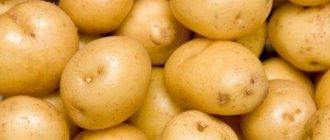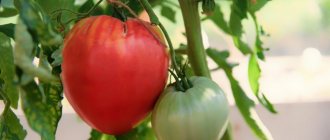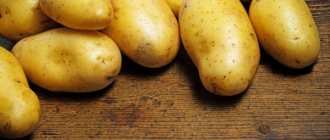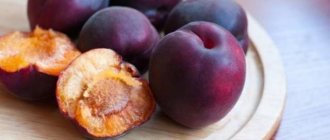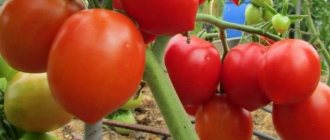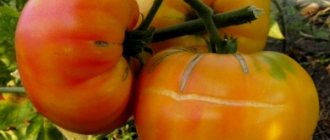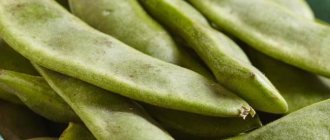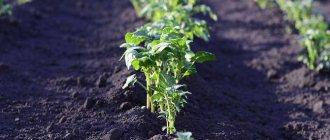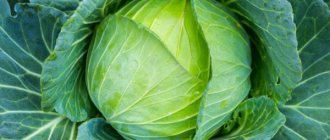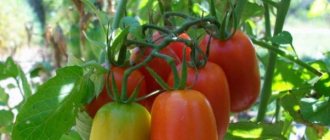Description of the variety
To successfully grow this variety, you need to know all its main features in order to create optimal growth conditions for young potato plants.
Appearance of potatoes
The bushes are distinguished by medium height and fairly strong tops. The shoots are erect and only after flowering is complete does lodging of the above-ground part of the bush occur. This process coincides with the beginning of tuber formation.
The leaves are dark green in color and medium in size. The flowers are pale lilac. The plants have a powerful, well-developed root system, which makes it possible to obtain 13-18 large tubers from one bush.
Fully ripened tubers are oval in shape with a smooth surface. The eyes are relatively small and evenly spaced. The peel will have a reddish tint.
The pulp is colored light yellow and does not darken when peeled. The average weight of one tuber is 110-155 g. This variety is distinguished by its multi-tuberism, which contributes to the formation of 18 full-fledged tubers.
Mayak potato planting dates
To get friendly and healthy shoots, you need to plant potatoes at the optimal time.
Such conditions arise when the soil at a depth of 12-16 cm warms up to + 12 degrees Celsius. Only at this temperature regime will the planted tubers begin to immediately form a root system and young shoots.
This soil temperature occurs in the first half of May. If you plant potatoes at an earlier date, this can cause fungal diseases to damage the planting material. Damage to tubers by soil pests (wireworms, mole crickets) is also possible. If you delay planting, there is a chance that the resulting seedlings will be exposed to drought conditions.
Potato ripening time
Potato Mayak is a mid-early variety.
The duration of the growing season from the emergence of seedlings to the full ripening of the crop lasts 79-85 days. Under the influence of weather and climatic conditions, the duration of the growing season can vary by 4-7 days.
Potato yield
The average yield of this variety ranges from 119-395 kilograms per hundred square meters. The maximum yields were obtained in the Perm region and amounted to 400 c/ha.
When using intensive cultivation technology using high doses of organo-mineral fertilizers, timely watering and fertilizing, you can get up to 500 c/ha.
Frost resistance of the Mayak variety
Plants are able to withstand short-term spring frosts down to -1 degree Celsius.
You can increase the frost resistance of potato plants if you carry out abundant moisture-recharging watering of the plants.
Disease resistance
Thanks to the productive work of the creators of this variety, it was possible to create planting material that is practically not affected by potato cancer, gray and white rot, scab and wrinkled mosaic.
The Mayak variety has average resistance to late blight. Therefore, during prolonged rainy weather, plants may be damaged by late blight.
We recommend an article about possible potato diseases, their recognition and treatment.
Keeping quality
When optimal conditions are created, the grown crop can be stored for 7-8 months.
At the same time, the shelf life indicator is 96-97%.
What regions is it suitable for?
The Mayak variety can be successfully grown throughout the Central regions of the country. Good harvests can also be obtained in the conditions of the Krasnodar Territory. In the more northern regions of the Urals and Siberia, the cultivation of Mayak potatoes can be effectively carried out only in heated greenhouses.
Mid-season potato variety "Mayak" with good adaptation to growing conditions
Among the many varieties of potatoes, Mayak stands out. This is a table variety, characterized by adaptation to various climate conditions and soils, productivity and ease of care. Suitable for growing in home gardens and on an industrial scale.
Let's consider a detailed description of the variety and the nuances of its cultivation.
Description
Potato Mayak is a mid-early variety. The bushes are of medium height, the tops are strong, semi-erect. The leaves are dark green, medium size, wavy. The flowers are pale lilac. The bush has a good root system, which allows the formation of 12-18 tubers under each plant.
We invite you to familiarize yourself with the Machine for making moonshine at home
The variety is easy to adapt to different soils and climatic conditions.
Description
Mayak potatoes are classified as table varieties. It was bred by breeders of the Federal State Budgetary Scientific Institution “Ural Research Institute of Agriculture”.
Recommended for cultivation in the Volga-Vyatka region: Sverdlovsk, Kirov, Nizhny Novgorod regions, Perm Territory, Mari El Republic, Chuvash and Udmurt Republics.
The starch content in tubers of the Mayak variety is in the range of 13-17.5%.
Potatoes contain a lot of proteins, carbohydrates, vitamins, micro- and macroelements.
Vitamin content in 100 g of raw potatoes:
- A - 2.83 mcg;
- B1 - 0.13 mg;
- B2 - 0.55 mg;
- B5 - 0.3 mg;
- B6 - 0.28 mg;
- B9 - 0.82 mg;
- C - 22.1 mg;
- E - 0.11 mg;
- RR - 1.32 mg;
- beta-carotene - 0.21 mcg.
Macronutrients:
- calcium - 11.2 mg;
- magnesium - 20 mg;
- sodium - 4.4 mg;
- potassium - 572 mg;
- phosphorus - 47 mg;
- sulfur - 28 mg;
- chlorine - 41 mg.
Microelements:
- iron - 0.89 mg;
- zinc - 0.31 mg;
- iodine - 5.1 mcg;
- copper - 136 mcg;
- manganese - 0.15 mg;
- fluorine - 0.28 mg;
- boron - 0.12 mg;
- aluminum - 0.85 mg.
Calorie content - 74 kcal. Nutritional value per 100 g of product:
- proteins - 2.4 g;
- fats - 0.4 g;
- carbohydrates - 18.1 g;
- starch - 17 g;
- ash - 1 mg;
- water - 76 g;
- dietary fiber - 1.52 g;
- organic acids - 0.24 g.
Reviews from gardeners about Mayak potatoes
Sergey, Moscow
I have been growing the Mayak variety for three years now. During this time, we managed to collect good harvests. Potatoes are tasty and store well. The lighthouse responds well to watering and fertilizing and immediately comes to life.
Anna, Samara
A productive variety with many tubers under the bush, they are well stored and have an excellent taste. I didn’t like the fact that to get a good harvest you need to water and feed the potatoes on time.
Olga, Cheboksary
I really liked the lighthouse potatoes. The harvests are always good. The tubers are good, the taste is excellent. I would also like to note that the harvest is well stored.
Reviews from experienced gardeners
Mayak potatoes are often discussed on thematic forums. There are no outright negative ones. Below are a few of the most revealing opinions.
- Vladimir from the Perm region writes: “The variety is new to us. I was surprised by its thoroughness and power. And the color is generally more suitable for radishes than for potatoes. Neighbors came to watch and everyone wanted to try it. Among those who tasted these potatoes, there were no dissatisfied ones. Everyone praised me. I will plant more next season.”
- Margarita from Yekaterinburg shares: “I was attracted by potatoes with their unusual appearance. I liked the yield and unpretentiousness. The family, including me, appreciated the taste and quality.”
- Vera Ivanovna from the Sverdlovsk region shares: “I’ve been growing it for several years in a row, and I couldn’t be happier with the variety. At first I was suspicious of its color, what if it was GMO? But the grandchildren laughed at my fears and explained in detail why there is such a color, and what is the benefit of such coloring. It also stores well, very few tubers spoil.”
In conclusion, we recommend watching a video about the results of growing the Mayak variety in a risky farming zone.
Planting potatoes in open ground
High-quality planting of potatoes is a very important element of the technology for growing this variety. All work must be completed on time and in accordance with existing recommendations.
Soil requirements
Mayak potatoes can be grown in all types of soil. But the maximum possible yields can be obtained on chernozems rich in organic matter. Therefore, in the fall, a large amount of organic matter is added at the rate of 8-12 kg. per 1 m2. Find out more about potato fertilizers.
Good results are obtained even on dense clay soils, provided that regular loosening and timely watering and fertilizing are carried out.
It is very important that groundwater is located no closer than 1 m to the soil surface.
Preparation of planting material
Preparation begins with removing the planting material from the storage location and performing manual sorting. In the process of this work, specimens with the presence of fungal diseases, rot or cuts are rejected.
Next, the tubers selected for planting are laid out in wooden boxes and placed for germination in a room where the temperature is maintained at + 20 degrees Celsius. After germination of the eyes to 2-4 mm, the tubers are ready for planting in a permanent growing location.
A few days before planting, the tubers are laid out in one layer on a flat surface and sprayed with a fungicidal preparation to destroy the infectious origin of dangerous fungal diseases. To learn how to sprout potatoes according to the rules, read the article.
Technology and planting scheme
Planting of prepared tubers is carried out in the first ten days of May, when the air temperature warms up to the optimal temperature regime. Depending on the growing region, planting dates may shift by several days.
For optimal lighting of potato bushes, an area without tall buildings or fences is selected. The optimal scheme for this variety is 25-30 x 70-80 cm. This planting scheme ensures rapid development and closure of adjacent rows, which negatively affects the development of weeds. The depth of planting holes or trenches should not exceed 12-14 cm.
One or two viable tubers are placed in each hole and sprinkled with loose and fertile soil on top.
Useful material:
How to plant potatoes correctly
Methods for planting potatoes
Planting and growing potatoes of the Mayak variety
Preliminary work begins in the fall: they get rid of weeds, dig deep into the soil, and apply organic and mineral fertilizers.
Treatment of tubers before planting is an important stage of planting
Preparing for landing
Planting material is healthy identical tubers without mechanical damage. A month before planting, they are germinated in a warm room and laid out in 2 layers in a box. Before this, the potatoes are treated with phytosporin, a bluish solution of copper sulfate. After the appearance of sprouts 1-1.5 cm long, planting in open ground begins.
Important! To activate growth, before sowing, the seed material is treated with epina or zircon.
Soil requirements
The variety requires good lighting and fertile soil. The soil must have good air permeability, looseness, low or neutral acidity; if it is high, it is necessary to add wood ash.
Important! Caked soil will cause deformation of potato tubers.
Dates, scheme and rules of planting
Planting activities begin at the end of May, after the soil has warmed to 10 °C. The timing depends on the weather conditions of the region. You need to plant seed according to the standard scheme:
- In 3 weeks, the area is dug up, urea and wood ash are added to the soil.
- The holes are dug at a distance of 28 to 30 cm, and a distance of 70 cm is maintained between the rows.
- The required depth of the hole is 10 cm, the tubers are laid with the sprouts facing up.
- They are covered with loose soil on top.
Note! At low temperatures, cover the potato beds with plastic wrap overnight.
Features of care
As soon as friendly shoots appear on the soil surface, systematic weed control begins. To do this, you need to loosen the soil to a depth of 1-3 cm. It is important that this work is carried out before the weeds take root.
To increase the volume of the root system and provide plants with better growing conditions, you need to perform double hilling. The first hilling is carried out when the young shoots have reached a height of 12-14 cm, the second when the potato shoots grow to a height of 15-17 cm. Reading the article about hilling potato bushes will help you do this work correctly.
To ensure intensive growth, Mayak potatoes require three feedings during the entire growing period.
- The first fertilizing is carried out after the first hilling. Fermented chicken manure diluted with water in a ratio of 1:13 is used. 6-7 liters are consumed per 1 m2. prepared solution.
- The second feeding should be done a few days before flowering begins. It is best to use store-bought liquid complex fertilizers containing a complex of microelements. The best in this category are: Energen Aqua (12-13 ml per 10 liters of water) and Vympel (11-12 ml per 10 liters of water). These preparations must be sprayed on the above-ground parts of potato bushes in the evening.
- The third fertilizing should be carried out when, after flowering, the tops begin to lie on the soil surface. During this period of time, the best solution is liquid mullein obtained by dissolving water in a ratio of 1:12. The consumption rate of this solution is 4-5 per 1 m2.
Learn more about fertilizing potatoes.
The Mayak variety requires timely watering, which should be done at the rate of 1 watering every 7-8 days. In order for potato plants to make maximum use of irrigation water, it is necessary to water in the evening.
After the soil surface has dried, you need to loosen it to a depth of 1-2 cm. This measure will prevent intense evaporation of moisture from the soil during the dry period.
Features of agricultural technology
Potatoes are grown in more than one hundred countries around the world. Standard agricultural technology for growing this popular vegetable crop in Russia requires compliance with the following recommendations:
- Potatoes are planted only after the soil has warmed up to positive temperatures;
- the soil for potatoes should be loose and fertile, with sufficient aeration and water permeability;
- The scheme for planting potatoes using the shovel method assumes a distance between potato bushes and rows of approximately 50-60 cm, which allows the plants to provide sufficient nutrition area;
- Irrigation measures should be properly organized, taking into account that the standard moisture requirement of this vegetable crop during different periods of growth and development varies;
- Exceeding the standard amount of nitrogen fertilizers in the phase of active plant development can have a negative impact on the quality parameters of grown potatoes, therefore fertilizing with such means should be replaced with the application of organic matter and mineral fertilizers.
When growing the Mayak potato variety, it is advisable to adhere to the standard rules presented.
Article on the topic: Potato variety “Azhur” - description and photo
After reading the corresponding article on our website, you can also learn about the varietal characteristics of high-yielding potatoes “Udacha”.
Diseases and pests
As mentioned earlier, the greatest danger for this variety is late blight.
Consequences of late blight
In this regard, before flowering begins, it is necessary to carry out two preventive treatments of the above-ground parts of the potato with the fungicidal drug Ridomil Gold.
The interval between two treatments should be 8-9 days. When the first signs of plant disease with late blight appear, you need to additionally spray two times with the above-mentioned drug.
To reduce the likelihood of late blight, it is important to adhere to the recommended crop rotation schemes with returning potatoes to their original place of cultivation no earlier than after 5 years.
Against soil pests (mole crickets, wireworms, false wireworms), poisoned Wofatox baits should be used and a crop rotation system should be followed.
But the most dangerous potato pest is still the Colorado potato beetle. Therefore, if there are more than 5 specimens on one bush, you need to immediately spray the plants with Metaphos, Karbofos or Bombardir insecticides.
Characteristics of the variety
Potato Mayak is a mid-early table variety. The duration of the Mayak growing season is 75-85 days. Productivity is in the range of 11.5-40 tons per 1 hectare of planting.
Potatoes are easy to care for and easily adapt to climatic conditions and soil type. Ideal for individual cultivation in personal plots.
The starch content in root vegetables ranges from 14 to 17.5%. The weight of mature potatoes can reach 150-160 g, but on average it is in the range of 95-130 g. The peel of Mayak is red, the flesh is light yellow. It is not prone to darkening during cleaning and heat treatment.
The root system is well developed. One bush can produce up to 18 large potatoes (on average, 12-15 pieces).
The lighthouse has good consumer qualities. The tubers have a pretty good taste and boil well. The culinary type of Mayak pulp is AB.
The variety stores very well. The keeping quality of the Lighthouse is within 97%.
Also, the variety has fairly good immunity. The lighthouse is resistant to diseases such as potato cancer, common scab, wrinkled and banded mosaic. In addition, it is rarely infested by golden nematode.
Less resistant to late blight of tops and tubers, and rhizoctonia.
Harvest and storage
When the above-ground part of the potato bush has completely dried and the peel has hardened, you can begin to dig up the grown crop.
Using a shovel or garden fork, dig up the tubers and, after clearing any lumps of soil, lay them out in one layer to dry.
After this, the tubers are sorted and sorted by size. Specimens suitable for storage are placed in baskets or boxes and transferred to a room for long-term storage. It is important that in this room the air temperature is constantly maintained at 0 +1 degrees. It is also necessary to maintain air humidity at 55-60%. What other conditions to maintain so that your crop can easily survive the winter can be found in the article on the rules for harvesting and storing potatoes.
You should have efficient ventilation that would promptly remove excessively humid air outside. During the entire storage period, it is necessary to regularly inspect the stored tubers and, if necessary, perform manual sorting.
If all of the above recommendations are followed, the grown crop can be successfully stored for 6-7 months.
How to harvest and store crops
Planted at the end of May, the crop fully ripens in September. For harvesting work, select dry and sunny weather to facilitate digging. The collected tubers are dried, sorted and stored in the basement. If the conditions are correct, the potatoes will retain their commercial characteristics and taste until the next season.
Storage features and shelf life of the Mayak variety
The collected potatoes are laid out in darkened rooms on dry surfaces for 7-10 days for final drying. It is necessary to maintain a temperature regime of 14-17 ° C and regularly ventilate.
If any defects are detected, tubers with rot are thrown away, those with mechanical damage are left for consumption. The sorted potatoes are sent to a basement with a temperature of up to 5 ° C and a humidity of no higher than 90%, as well as normal ventilation. Seed material is stored in separate boxes.
For your information! The keeping quality of potatoes is 97%. If the conditions are met, it can be stored for up to 7.5 months.
Advantages and disadvantages of the variety
The advantages of the variety include:
- high yield rates;
- good adaptation to different climatic conditions;
- unpretentiousness in cultivation;
- excellent keeping quality.
The disadvantages of the variety are:
- demanding on soil moisture and quality (shows good yield indicators only on fertile soils);
- average resistance to late blight.
Difference from other varieties
Compared to other varieties, Mayak produces a large number of tubers. To obtain high yields, it needs well-prepared, fertile soils.
Correct fit
When growing Mayak, standard agricultural practices are followed, which include:
- Potatoes are planted only when the soil warms up to +8-10 C.
- Tubers should be planted in a sunny, well-ventilated area. Also, special attention is paid to the soil. It must be fertilized (the soil is fed in the fall) and loose.
- There should be no weeds on the site. It inhibits the crop, thereby slowing down the development of root crops.
- During planting, about 60-70 cm are left between the rows, and about 35-40 cm between the holes. Such large row spacing is needed for at least several reasons. Firstly, the larger the row spacing, the more convenient it will be to carry out hilling. Secondly, this ensures good natural aeration and illumination.
- The planting depth in light sandy loam soils should not exceed 10 cm. In heavier soils, the tuber planting depth is reduced to 5-6 cm.
- If the soil is well fertilized in the fall, then, in general, there is no need to carry out additional fertilizing. However, if it is poor in organic matter or has a very complex structure, then it is necessary to add ash to each hole during planting of the material. If there is no ash, you can use any other fertilizer; in particular, humus is perfect.
Related article: Potato variety “Red Fantasy” - description and photo
